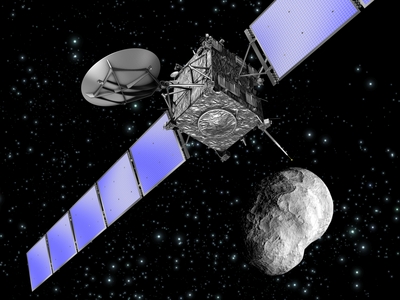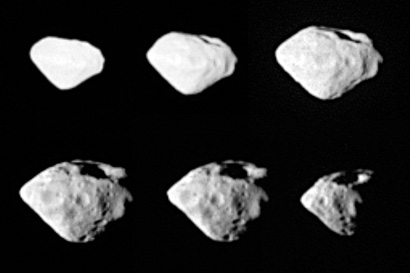
Rosetta Spacecraft Reaches Asteroid Steins

September 6, 2008
 On September 5th, 2008, the Rosetta Spacecraft flew by asteroid Steins
as the spacecraft races around the solar system in its ten-year voyage
to comet 67P Churyumov-Gerasimenko. Rosetta flew by the 5 km asteroid
at a distance of only 800 km, taking photos, and making measurements
with several other instruments.
On September 5th, 2008, the Rosetta Spacecraft flew by asteroid Steins
as the spacecraft races around the solar system in its ten-year voyage
to comet 67P Churyumov-Gerasimenko. Rosetta flew by the 5 km asteroid
at a distance of only 800 km, taking photos, and making measurements
with several other instruments.
Rosetta contains two SwRI-built instruments: the Alice UV spectrometer and the Ion and Electron Sensor (IES) of the Rosetta Plasma Consortium. Joel Parker at SwRI's Boulder office is the project manager and acting Principal Investigator for Alice, and James Burch at SwRI's headquarters in San Antonio is the Principal Investigator of IES. Alice observed Steins throughout the flyby, and was the first UV spectrometer to travel to an asteroid. The scientific objectives for Alice during this flyby were to search for an "exosphere" (a thin atmosphere) and study the materials that make up the surface of the asteroid. Dr. Parker reports that Alice performed wonderfully and as planned, "We got a beautiful spectrum of the asteroid during the closest approach phase of the flyby that will keep the science team happily busy. Alice also took measurements every second of how bright Steins appeared in the ultraviolet. The variation in the brightness as Rosetta flew by will tell us about the properties of the asteroid's surface."
 Steins is Rosetta's first nominal scientific target. Based upon ground-
based observations, it has been classified as an 'E-type' asteroid,
composed mainly of silicates and basalts with little or no iron
content, but its properties are not known in detail. Such asteroids
are quite small in size and orbit and are mostly found in the inner
part of the main asteroid belt located between Mars and Jupiter. They
probably originate from the mantle of larger asteroids destroyed in
the early history of the Solar System. No E-type asteroid has been
directly observed by an interplanetary spacecraft before. For these
reasons, it was selected as one of the two asteroids that Rosetta will
study, from among those that were within reach of the mission (Rosetta
will fly by asteroid Lutetia in 2010). The study of asteroids is
extremely important as they represent a sample of Solar System
material at different stages of evolution - key to understanding the
origin of our own planet and of our planetary neighborhood. Steins is
a small asteroid of irregular shape (this flyby clarified it has a
"diamond" shape), with a size of about 4x6 km.
Steins is Rosetta's first nominal scientific target. Based upon ground-
based observations, it has been classified as an 'E-type' asteroid,
composed mainly of silicates and basalts with little or no iron
content, but its properties are not known in detail. Such asteroids
are quite small in size and orbit and are mostly found in the inner
part of the main asteroid belt located between Mars and Jupiter. They
probably originate from the mantle of larger asteroids destroyed in
the early history of the Solar System. No E-type asteroid has been
directly observed by an interplanetary spacecraft before. For these
reasons, it was selected as one of the two asteroids that Rosetta will
study, from among those that were within reach of the mission (Rosetta
will fly by asteroid Lutetia in 2010). The study of asteroids is
extremely important as they represent a sample of Solar System
material at different stages of evolution - key to understanding the
origin of our own planet and of our planetary neighborhood. Steins is
a small asteroid of irregular shape (this flyby clarified it has a
"diamond" shape), with a size of about 4x6 km.